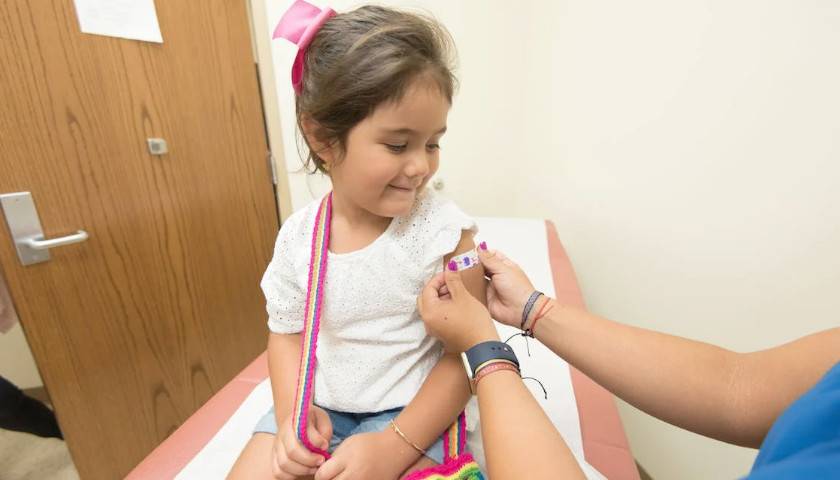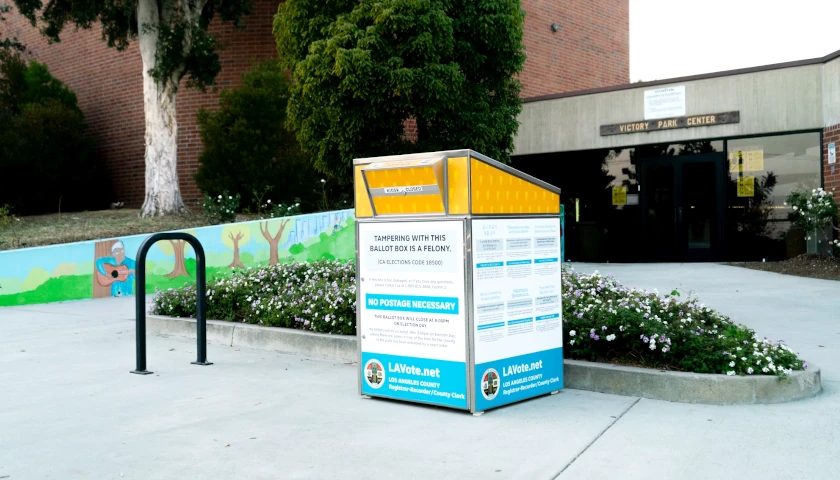by Greg Piper
New research on how COVID-19 vaccines affect children and nursing mothers, and the government’s own estimates of severe side effects in teenagers, is putting scrutiny on the CDC’s recommendation that all ages stay “up to date” with newly authorized formulations.
Fully vaccinated versus unvaccinated children under age 5 were roughly as likely to require medical visits among those testing positive for SARS-CoV-2 in a large California study, challenging the Centers for Disease Control and Prevention’s claim that the shots “protect children against severe disease and hospitalization.”
A small Australian study found that 5-11 year-olds after vaccination had weaker immune responses to non-COVID infections. Trace amounts of mRNA were found in breast milk tested up to 45 hours after vaccination among lactating mothers in a small New York study.
Before recommending the new Omicron XBB.1.1-based mRNA vaccines this month, the CDC’s own Advisory Committee on Immunization Practices reviewed trial data that showed a high rate of “severe” side effects among 12-17 year-olds who took the original monovalent vaccines.
Page 56 of the “Evidence to Recommendations Framework” shows 750 reactogenicity “events” categorized as “grade 3” or higher among 3,616 teens in applications for full vaccine approval by Pfizer (ages 12-15) and Moderna (12-17).
Possibly due to its higher dosage, Moderna’s severe event rate was 25% compared to Pfizer’s 11%.
The National Institutes of Health defines grade 3 as “incapacitating; unable to perform usual activities; requires absenteeism or bed rest.”
By contrast, the CDC estimates every million vaccinations of 12-17 year-olds prevents zero to one COVID-related death, according to page 65 of the framework.
Again, from @CDCgov’s OWN data:
1 million mRNA Covid shots for teens will prevent
0-1 Covid deaths
and CAUSE
100,000-200,000 severe side effects.
Yes, you read that right. pic.twitter.com/GXpgIw3DvC
— Alex Berenson (@AlexBerenson) September 13, 2023
Former Brown University epidemiologist Andrew Bostom pointed out Wednesday that the CDC’s own pediatric seroprevalence figures show all minors tested positive for COVID antibodies in the most recent eight-week survey in Brown’s home of Rhode Island. He said the virus has become “the common covid cold” for kids.
The research comes as the summer wave of COVID infections and its attendant alarm about new variants appears to have peaked on average, calling into question the feds’ call to get new jabs starting two months after the last.
NBC News reported Tuesday that wastewater-surveillance company Biobot Analytics found 5% lower COVID levels nationwide this week compared to last, while the Stanford-Emory research project WasteWaterSCAN found “flattening” more than “true downturn.”
Among nearly 1,000 wastewater sites partnering with the CDC, 36% show decreases in COVID levels, 8% no change and 56% rising as of Sept. 11, and a tiny decline in test positivity overall as of Sept. 9. CDC data also show the negligible increase in COVID-related deaths this summer, near an all-time low, has already reversed.
Reminder: By Dec 2022, essentially ALL RI children 0-17 years old had been SARS-COV-2 infected without a single covid fatality, & that remains true at present.
No need to mRNA vax RI kids for what is clearly now the common covid cold! pic.twitter.com/RS9axTILIw— Andrew Bostom, MD, MS (@andrewbostom) September 20, 2023
The Journal of the American Medical Association published a “research letter” last week coauthored by three researchers affiliated with Pfizer, based on a Kaiser Permanente Southern California (KPSC) study funded by the pharmaceutical company.
Among nearly 177,000 emergency, urgent care and outpatient visits for acute respiratory infections from July 2022 through May 2023 for children 6 months through 4 years, researchers found 2,300 COVID infections in 24,000 tests performed. Only 6% of tested children were vaccinated, defined as two or three Pfizer doses.
The FDA let Pfizer add a third dose after it started the trial in young children because two weren’t showing “non-inferiority,” with the agency authorizing the three-dose schedule as their primary series, which is also what the CDC recommends.
While the study found those who received “at least 2” doses had a lower risk of these medical visits than unvaccinated children, the researchers played down the differences between two and three doses, which are only addressed in a chart and one sentence in the “discussion” section.
Children Younger Than 5: "The risk of SARS-CoV-2 encounters appeared lower for those with 2 vs 3 doses of BNT162b2, albeit with wide CIs, which is likely due to more immune-evasive Omicron sublineages…." https://t.co/H1hBAaOFpu pic.twitter.com/TGpzDej06d
— Association of American Physicians & Surgeons (@AAPSonline) September 15, 2023
Three doses has an adjusted odds ratio just under 1, which means no effect, and a confidence interval whose upper boundary substantially crosses 1, meaning even less certainty. The adjusted OR for two doses was 0.5, a strong effect against medical visits, and an upper CI boundary below 1.
The apparently lower risk of “SARS-CoV-2 encounters” for two versus three doses “is likely due to more immune-evasive Omicron sublineages (eg, BQ.1-related and XBB-related strains) becoming dominant by the time young children received their third dose and longer median time since dose 3 compared with dose 2,” they wrote.
Former Surgeon General Jerome Adams touted the study without apparently noticing the conflation of doses.
ICYMI: Receiving at least 2 doses of wild-type BNT162b2 vaccine was associated with a ⬇️ risk of COVID-19 ED or UC and outpatient visits in children younger than 5 years.
Receipt of BNT162b2 Vaccine and COVID-19 Ambulatory Visits in US Children https://t.co/MRwfdh2ii8
— Jerome Adams (@JeromeAdamsMD) September 15, 2023
The researchers’ combination of two and three doses while leaving out one-dose recipients entirely is “scientifically bizarre,” given that Pfizer and the feds agree three doses is standard for young kids, former New York Times drug industry reporter Alex Berenson wrote. A vaccine that performs worse with more doses “lacks any biological plausibility.”
The study’s corresponding author, Sara Tartof in KPSC’s Department of Research & Evaluation, did not respond to Just the News queries to explain the framing of the study. The paper’s conflict-of-interest disclosure shows she received “grants from Pfizer paid directly to her institution during the conduct of the study.”
The Australian study, published last month in Frontiers in Immunology, took blood samples from 29 children 5-11 years of age who were part of a “well-described cohort followed up since birth.”
Researchers analyzed their “in vitro cytokine responses” to several pathogens before and 28 days after Pfizer vaccination, with eight of them also analyzed six months later.
Crucial immune responses to eight of the pathogens, including E. coli, influenza and hepatitis B, “decreased compared to pre-vaccination” at 28 days, while there were “sustained decreases in cytokine responses to viral, but not bacterial, stimulants” at six months, the researchers found.
The implication that a COVID vaccination can alter immune response to diseases, not all vaccine-preventable, is “particularly relevant in children” because of their “extensive exposure to microbes at daycare, school, and social occasions,” often for the first time, and they receive many vaccines in the childhood schedule, they wrote.
Study in Frontiers raises concerns re prolonged reduced immune response in children against viruses & bacteria post mRNA vax.
Adds to cumulative evidence suggesting adverse immune alteration by COV vax.
Pfizer’s children trial had more vaccinated hospitalized with illnesses! pic.twitter.com/B8vKvwrDdk
— Retsef Levi (@RetsefL) August 30, 2023
The New York University medical school study, published Tuesday in The Lancet journal eBioMedicine, collected breast milk samples from “13 lactating, healthy, post-partum women before and after COVID-19 mRNA vaccination,” a population “largely excluded from most vaccine clinical trials.”
Ten of the 20 vaccine “exposures” had detectable mRNA, concentrated in the extracellular vesicles, though they “neither expressed SARS-COV-2 spike protein nor induced its expression” in the cell line used by the researchers. The mRNA retained 12-25% of its “original integrity.”
“Although we believe breastfeeding after mRNA vaccination is safe” and the mRNA “appears to be translationally inactive,” the researchers said healthcare providers should talk to mothers about the benefits and risks of breastfeeding in the first two days after vaccination. Further research is needed to determine how much mRNA is needed for newborns to “elicit an immune response.”
“Of 13 lactating women receiving the vaccine (20 exposures), trace mRNA amounts were detected in 10 exposures up to 45 h post-vaccination.
Our findings suggest that the COVID-19 vaccine mRNA administered to lactating mothers can spread systemically to the [breast milk] in the… pic.twitter.com/u5SHdZrszD
— Chief Nerd (@TheChiefNerd) September 19, 2023
The CDC did not answer queries for its defense of one-size-fits-all vaccination recommendations in light of the research and its own data.
Greg Piper has covered law and policy for nearly two decades, with a focus on tech companies, civil liberties and higher education.




